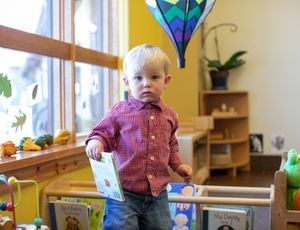Movement has always been an essential tool for the survival of every living being since it allows them to reach what is needed and avoid what is harmful. In the first years of the life of a baby, movement is one of the most critical aspects of development. In this month’s article, we will look into the physical and psychological aspects of movement and how we can better prepare ourselves and the environment for it.
When a child is born, the only body parts he can control voluntarily are his mouth (the muscles that allow him to suck the milk from the breast or bottle) and his throat (the muscles that will enable him to swallow the milk). The rest of the body parts will need to be used many times before achieving a voluntary, coordinated movement. Unfortunately, most of the time a newborn is often wrapped tightly in a blanket, placed in a crib, and dressed in a way that any movement is inhibited. We tend to think that infants are not capable of moving, but even if they cannot move like adults, they still can and should move their bodies freely.
How do they conquer movement?
Through repetition. Children are born with billions of neurons ready to make connections with each other; this process is called myelination. For a connection to be made, there needs to be plenty of repetition of the same movement. This is why we highlight the importance of allowing the baby to move every part of his body with freedom; avoid placing him in restrictive containers that do not allow the repetition of movement as it hinders the myelination process needed for the development of movement. If we think about how the baby was always able to move all parts of the body in utero, it is strange that after birth, he finds himself trapped in restrictive structures or clothing.
Top 6 Unnecessarily Popular Restrictive Containers
- Swaddle: This item completely restrains the movement of the child. It does not allow them to move their arms, look at their hands, or bring them to their face as a point of reference like they did in the womb. This lack of movement numbs the child, and more than likely, he will fall asleep since there is nothing else he can do with his body other than wait for the adult to release him. Just imagine if you were restrained in an adult size swaddle; how would that make you feel? Would you like to be able to move your arms and hands?
- Excersaucer: This item can be detrimental to the child’s development. Usually, a child that cannot even pull up from furniture is placed in this item. His back is not ready to support the entire body, and he will use his tiptoes to touch the base of the Excersaucer, which makes all the muscles of the foot work in a way that he is not ready for. Later on, many of the children left in Excersaucers will walk on their tiptoes because of the overstimulation they received previously.
- Bumbo Seat: Children that are not able to sit by themselves should not be placed in containers that force them to do it. This item is usually used for very young children to “teach” them to sit. The truth is that their back is not strong enough yet, and the child needs the adult to get him in and out of the seat without any independence. We should provide multiple opportunities for the child to work his back in a healthy and natural way that he can do by himself.
- Playards: It is common to leave children unattended in these structures for long periods. This means that the freedom of movement is restricted continuously. The child needs an adult to be put inside the playard and to be taken out of it as well. We can observe many children crying when placed in them or crying desperately to get the adult’s attention and take them out. The human connection is often missed; it does not foster stronger relationships or any trust in the environment.
- Bouncers: These inhibit the use of the back muscles. Usually, when children are placed in bouncers, they fall asleep and are not able to move since the body is suspended in the fabric, and they have a strap around their waist. Also, when adults try to make them sleep, they often make it bounce at a pace that over stimulates the child and inhibits the possibility of listening to their body’s needs.
- Crib: In some cultures, there are no cribs, and children sleep on a futon at floor height. Cribs were designed for the adult; it makes it more comfortable to bend at crib height and to keep the child inside it until it is decided the child can come out. Instead, a low bed offers freedom of movement for the child to go to sleep when he wants and to get out of the bed when he is no longer tired. This will also stimulate the movement of the neck and tracking with the eyes since there is so much to observe in the room, not just the ceiling or bars to the sides.
- Bulky and stiff clothing: Clothing with bulky latches like belts hinder the movement of the child. It would be uncomfortable for the child to be slithering on the rug with a belt on his belly; it will give him negative feedback of movement. Make sure the clothing the child uses is comfortable enough to allow movement of all limbs and is a correct for the temperature he is exposed to. Leave him barefoot as much as the weather allows it so he can use all the muscles of the foot when moving.
An adult that Fosters Freedom of Movement
Observation is the key. Observe your baby, identify patterns, identify which new movement he is doing, and encourage the repetition of that movement. Recognize what is hindering the freedom of your child to move and make the necessary adjustments. There is no need to buy expensive gadgets that promise to keep your baby “busy” and entertain him. The only tool you need is subjective observation and space for him to move; the rest will follow naturally.
Quote of the Month
“Movement is of great importance for a child. It is the functional incarnation of the creative energy which brings man to the perfection of his species. Through movement, he acts upon his external environment and thus carries out his own personal mission in the world”
- Maria Montessori
Item of the Month
Floor Bed
The idea of the floor bed is based on Montessori principles of allowing children to explore and learn through their environment. It can simply be a mattress on the floor, or you can get a frame for the mattress. The goal is that the child can get in and out independently and have a free view of the environment.
Link to buy a wooden frame for the mattress at Sprout.com
https://sprout-kids.com/products/low-montessori-floor-bed-for-toddlers
Have a Little Extra Time?
Get your headphones and enjoy this one-hour conversation with two well-seasoned Montessorians, Jeanne-Marie Paynel and Simone Davies. They will share what observation is, how observation can be done at home, and the benefits it has. Enjoy!
https://www.youtube.com/watch?v=xVHJlIch5nk



